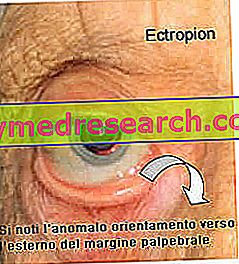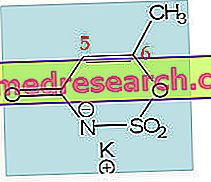Generality
The epiphora is the eye that tears excessively, due to an eye disorder or a morbid condition of the eyes.

- the occlusion (or narrowing) of the system that drains the tears in the nose;
- an overproduction of tears due for example to an irritation of the eyes
- an infrequent (or impossible) blinking.
Other signs or symptoms can often be added to the epiphora; these vary according to the causes favoring.
In the presence of an epiphora, it is very important to establish the precise reasons for the onset, as this allows to plan the most appropriate treatment.
In less severe cases, the patient could also recover spontaneously; in more serious situations, on the other hand, it requires specific care.
What is the epiphora?
Epiphora is the medical term that indicates an excessive release of tears from the eyes.
A synonym of epiphora, widely used in common jargon, is " eye that tears " or " eyes that tear ".
The teary eye is a characteristic clinical sign of various disorders and real eye diseases, including conjunctivitis, uveitis, entropion, blepharitis, etc.
HOW DO THE EYE TRACTION WORK?
To understand the possible causes of epiphora, it is necessary to briefly describe how ocular tearing occurs and which anatomical structures of the eye are involved in this process.
On the inner face of the upper eyelids, the tear glands reside, which, as can be guessed from the name, secrete tears. The activity of the lacrimal glands is constant.
Under normal conditions, tears are a sort of slightly oily liquid film (the so-called tear film ), which serves to defend, lubricate, nourish and keep the eye clean.
The volume of tears making up the tear film remains stable, since, on the inner side of the eye, there is an exhaust system, which continuously drains the tears in excess.
The tear discharge system is composed of:
- Canaliculi, which are small canals.
- The lacrimal sac, which is a sort of small reservoir fed by canaliculi.
- The lacrimal duct (or nasolacrimal duct ), which is the vent channel of the lacrimal sac. Through the tear duct, tears are carried into the nose (nasal turbinates) and then into the throat.

Epidemiology
The epiphora is very common among very young children (infants less than a year old) and people over the age of 60, but, in reality, it can occur in people of any age.
Depending on the causes, it can only affect one eye or both eyes.
Causes
The epiphora can arise for at least three reasons:
- Due to an occlusion or narrowing in the tear discharge system ( dacriostenosis ), particularly at the level of the nasolacrimal ducts or.
- Because of an overproduction of tears from the lacrimal glands.
- Because of an infrequent or impossible blink of the eyelids .
OCCLUSION OF THE LACRIMAL DISCHARGE SYSTEM IN ADULTS
The occlusion or narrowing of the tear ducts causes the tears, after completely filling the lacrimal sac and the canaliculi, overflowing from the discharge system and coming out of the eye.
Added to this is the fact that the lack of drainage of tears leads to their stagnation inside the lacrimal sac. Tears that stagnate can, in the long run, host infectious bacteria or cause swelling to the side of the nose ( mucocele, or accumulation of mucus ). If not properly treated, the presence of infectious bacteria in the tear discharge system could result in an abscess .
Occlusion of nasolacrimal ducts can be the result of:
- Advanced age
- Ocular inflammation (uveitis or scleritis)
- An ocular trauma
- A compression from the outside of the tear ducts
- The ectropion (ie the condition whereby the eyelid is facing outward)
When the occlusion affects the canaliculi
Sometimes, in adults, the occlusion of the tear discharge system resides in the canaliculi. Occluding or narrowing the canaliculi can be some viral infections or certain traumas.
OCCLUSION OF THE LACRIMAL DISCHARGE SYSTEM IN NEWBORN (CONGENITAL DACRIOSTENOSIS)
The occlusion of the tear ducts in newborns is the result of a delayed development of the tear ducts themselves. Often, after one year from birth, children with this anomaly heal, because the system that drains tears concludes their development.
It is very rare that after 12 months the occlusion persists, but if this should occur, there is a special treatment for the release of tear ducts.
HYPERPRODUCTION OF TEARS BY THE LACRIMAL GLANDS
Excessive production of tears by the tear glands can take place for several reasons, such as:
- An eye irritation . They can irritate the eyes: smoke, dust, some substances released from food (onions etc.), a conjunctivitis (ie an eye infection that inflames the conjunctiva), an allergy, an ocular trauma (due for example to the entry of a grain of sand in the eye), entropion (ie rotation of the eyelid inward) and ectropion.
- An abnormal composition of the tear film . The tear film contains various substances: water, mucus, proteins, lipids, etc. If the normal composition of the tear film undergoes a change (for example the lipid content varies), the distribution of the same film on the eye is no longer homogeneous and correct. This triggers an overproduction of tears from the lacrimal glands, tears that then come out of the eye. In fact, it is a compensation mechanism: the tear film is inadequate and the lacrimal glands are activated to remedy this inadequacy.
One cause of a change in the composition of the tear film is the so-called dry eye syndrome.
- Blepharitis . Blepharitis is a chronic inflammation of the eyelids, which affects the so-called eyelid margin and can cause (precisely on the eyelid margin) redness, swelling, itching, crusting, stinging pain etc.
Often, the aforementioned effects of inflammation alter the distribution of the tear film and this causes the lacrimal glands to activate, to bring the tear film back to normal.
It is important to note that, in the above circumstances, the tear discharge system works properly, but the production of tears is so massive that its drainage capacity is insufficient. So the tears come out of the eyes.
INFREAMENT OR IMPOSSIBLE BATTLE OF STUFFS
Proper beating of the eyelids is a fundamental action to direct excess tears towards the tear discharge system.
This explains why those who are unable to blink due to some morbid condition (for example, Bell's palsy ) are also subject to a teary eye.
Symptoms
The epiphora can appear alone or together with other disorders or particular signs.
The symptomatology that can accompany the tearful eye obviously depends on what triggers this eye condition. For example:
- In the case of conjunctivitis, at the epiphora are usually added: red eye, burning eyes, eye pain, palpebral swelling, itching and / or dry eye.
- In the case of dry eye syndrome, the following are commonly added to the epiphora: eye fatigue, burning eyes, eye pain, photophobia (ie sensitivity to light), red eyes, itching, dry eyes and / or blurred vision.
- In the case of entropion, the following are usually added to the epiphora: eye redness, pain around the eye, photophobia, wind sensitivity, relaxation of the skin surrounding the eyes and / or reduced vision.
- In the event of an occlusion of the nasolacrimal duct, the following can be added to the epiphora: bacterial proliferation at the level of the lacrimal sac, mucocele and / or abscess at the mucocele.
WHEN YOU GET BACK TO THE DOCTOR?

Diagnosis
When suffering from an epiphora, it is important to establish what causes it: in fact, knowing the precise causes of the eye that tears makes it possible to plan the most appropriate therapy.
Through a thorough physical examination, a general practitioner can tell if the epiphora is due to an overproduction of tears or a problem with the tear discharge system.
To be more precise, in the first case, it also goes back to what causes tears to be overproduced (conjunctivitis, eye irritation, blepharitis, etc.); in the second case, on the other hand, it only succeeds in ascertaining the presence of an insufficient tear drainage and advises, due to the lack of diagnostic tools adequate to the circumstance, a specialist visit to an ophthalmologist .
OPHTHALMOLOGICAL VISIT
During the ophthalmological examination, the ophthalmologist instills an anesthetic eye drops in the patient's eye, since the examination includes some rather invasive and annoying diagnostic procedures.
So, once anesthesia is practiced, it can:
- Inject, through a cannula previously inserted in a lacrimal canaliculus, a sterile solution . If the draining system is patent, the sterile solution reaches the throat (and the patient feels its presence); if, on the other hand, the draining system is occluded or restricted, the sterile solution remains blocked in a point of the nasolacrimal ducts (and the patient does not feel anything).
- Instill a special contrast liquid in the eyes and assess, after 5 minutes from the application, if and how much this contrast liquid has been drained by the tear discharge system. In the presence of an occlusion or a narrowing, after 5 minutes the contrast liquid will still be present on the ocular surface.
- Instill in the eyes a contrast liquid visible to X-rays and observe, using a special instrument for reading ionizing radiation, how this special liquid is distributed within the tear discharge system. If there is an occlusion, this is perfectly visible to X-rays, since it appears as an interruption to the passage of the contrast liquid.
Treatment
Epiphora therapy depends on how serious the problem is and the triggering causes.
The less severe cases of epiphora do not require special treatments and their recovery generally occurs quite spontaneously.
TREATMENT IN CASE OF SKIN IRRITATION
To resolve an epiphora caused by eye irritation, it is necessary to treat what triggers the irritation.
Therefore:
- In the presence of an eye infection. If conjunctivitis is bacterial, antibiotic therapy is needed; if, instead, conjunctivitis is viral, it is generally necessary to wait for the infection to heal spontaneously.
- In the presence of an allergy. The expected therapy usually consists in taking antihistamine drugs, which reduce the inflammatory state typical of allergic manifestations.
- In the presence of a foreign body in the eye. The solution envisaged consists in removing the foreign body .
- In case of entropion or ectropion. If entropion and ectropion are serious, it is possible to resort to surgery aimed at correcting the position of the eyelids.


If the defect of the tear discharge system is mild and bearable, the patient can try to live with this problem and not resort to particular treatments.
If, on the other hand, the occlusion is severe and prevents you from driving, reading, playing sports or other normal daily activities, it is essential to resort to a specific surgical operation, called dacriocistorinostomia .
Through the operation of dacryocystorhinostomy, the surgical creates a new nasolacrimal duct thus restoring drainage (NB: it is a sort of bypass that eludes the obstacle). Dacryocystorhinostomy requires general anesthesia, lasts about an hour and involves the removal of a small bone lamina, located between orbit and nostril.
Finally, it is recalled that, if the stagnation of tears led to the formation of an abscess, it is necessary to take antibiotics.
Release of occluded canaliculi
If the occlusion or the narrowing reside in the canaliculi, it is possible to free them by inserting thin glass tubes (in English, these tubes are called Lester Jones Tubes ).
HOW TO TAKE THE OCCLUSION OF HIDDEN BODIES IN CHILDREN
In most cases, the epiphora in newborns heals spontaneously once the tear discharge system (still immature) has completed its development. The estimated age for healing is around the year of life.
In the rare cases in which the draining system remains incomplete (one case in 10), it is necessary to resort to a specific surgical intervention for the reopening of the nasolacrimal ducts; this intervention requires general anesthesia.
How to encourage the drainage of tears in newborns with immature tear ducts
To encourage lacrimal drainage, doctors advise parents to gently massage the inner corner of their child's eyes. According to some experts, this maneuver would also seem effective in speeding up the maturation of the tear discharge system.
Before performing the massage, it is always advisable to wash your hands very well.
Prognosis
The prognosis in the case of an epiphora depends on the severity of the triggering causes: in fact, the more severe the underlying condition, the more difficult it is to cure the epiphora permanently.



